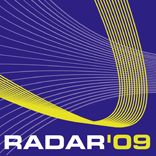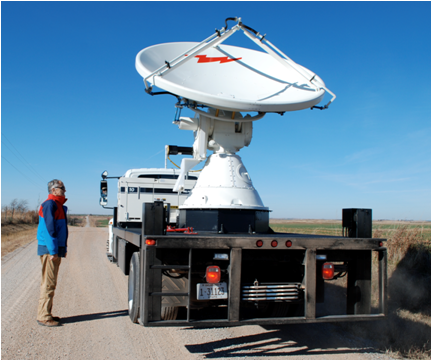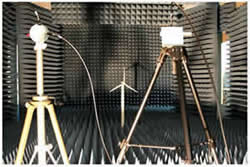In the context of collaboration between NSSL and the UK Met Office, I spent one week in Exeter working with UK Met Office scientists and engineers on their operational implementation of the CLEAN-AP filter. >>Read more
[Spring 2016]
I had the honor of presenting at the first NSSL 'Gab at the Lab'. In addition to improving the understanding of activities ongoing at NSSL and restoring/enhancing a sense of community, ’Gab at the Lab’ meetings provide opportunities to develop public-speaking skills and to practice explaining one’s work at a layperson’s level. >>Read more
[Fall 2015]
The Spring 2014 software release on the NWRT PAR is now operational. This new release enables multifunction capabilities and adds new signal processing and adaptive scanning functionalities. >>See a timeline of upgrades
[Spring 2014]
During PARISE 2013, NSSL scientists worked with NWS forecasters to understand the strengths and limitations of weather-radar scan strategies in their warning-decision process. >>Read more
[Fall 2013]
We recently received National Science Foundation (NSF) funding for our research project titled "Understanding Polarimetric Radar Tornadic Debris Signatures Using Modeling, Simulations, and Field Measurements." >>Read more
[Fall 2013]
The Spring 2013 software release on the NWRT PAR is now operational. Among other things, this new software release adds and improves adaptive scanning capabilities, a very timely accomplishment as we enter the busiest season for radar data collection. >>See a timeline of upgrades
[Spring 2013]
In a 2008 survey about scanning strategy improvements for the WSR-88D conducted by the US National Weather Service (NWS), 62% of forecasters indicated the need for faster updates. High-temporal resolution data (~1 min) is expected to improve the understanding, detection, and warning of hazardous weather phenomena. >>Read more
[Spring 2013]
SINARAME (a consortium of government agencies involved in the development of Argentina's National Weather Radar Network) hosted the symposium in Buenos Aires on September 11-13, 2012. >>Read more
[Fall 2012]
In our last annual report to the NWS Radar Operations Center, we document the CLEAN-AP filter, which will become part of the NEXRAD network in the near future. >>Read more
[Spring 2012]
The Argentine government approved a plan to design, build, and install a national network of weather radars. On Nov. 2011, I was invited to teach a short course. >> Read more
[Fall 2011]
The second summit between Kyoto University and the University of Oklahoma took place at the National Weather Center on Sept. 14-16, 2011. I was the chairman of the local organizing committee, a role that was both exhausting and rewarding. >>Read more
[Fall 2011]
On May 18, I was interviewed by Rick Mitchell, chief meteorologist from Oklahoma City channel 5 (KOCO). >>Read more
[Spring 2011]
In May 2011, I was invited by the Polytechnic University of Madrid and the Spanish Meteorological Agency to judge a dissertation defense, exchange collaboration ideas, and teach a short course. >>Read more
[Spring 2011]
A preliminary look at the data collected during last spring suggests that we’re getting a “free lunch”. That is, we are able to get lower errors of estimates with shorter dwell times! >>Read more
[Spring 2011]
In our last annual report to the NWS Radar Operations Center, we document the staggered pulse-repetition-time (SPRT) algorithm that will become part of the NEXRAD network in the near future. >>Read more
[Spring 2011]
At the 2010 European Radar Conference in Sibiu, Romania, I was invited as panelist for the workshop "Future radar systems - where do we stand in 10-20 years?". This workshop was chaired by Martin Hagen from the Institut für Physik der Atmosphäre (Institute of Atmospheric Physics) in Germany and featured five panelists, including myself.
The scope of this workshop was to discuss future radar technology that are currently under development or in the design stages. After each panelist's short presentation, the audience was encouraged to ask questions and/or make comments. The disccusions than ensued were very interesting and paradoxically timely (remember that Doppler and polarimetric radars took more than 20 years between their first use for research and operational application!)
With the goal of having a glimpse into the weather radar technology that will be available for operational use by weather services in 20 years, the panelists discussed topics such as pulse compression, collaborative networks, and esoteric designs. I took this great opportunity to discuss the unique capabilities that phased-array radar technology offers for weather observations in a multifunction environment. I addressed not only the advantages, but also the challenges that we face as we enter into the next technological era after dual polarimetry.
[Fall 2010]
Efficient sampling of storms is a critical need for forecasters in severe weather warning situations. Phased array radar technology, with its electronically steered beam, has the potential to meet this need by giving users the ability to control how, when, and where the radar scans. This means the radar can be directed to focus its beam only where storms are detected, without the mechanical inertia associated with rotating a parabolic antenna. Focused observations of storms lead to faster updates since the radar does not waste time scanning clear-air regions.
NSSL/CIMMS researchers developed the Adaptive Digital signal processing Algorithm for PAR Timely Scans (ADAPTS) to take advantage of this ability by “turning on” or “turning off” individual beam positions based on storm continuity, coverage and significance. ADAPTS also includes criteria to continuously monitor low-altitude developments and follow storm movement and growth. The original prototype was tested during the spring of 2009 and demonstrated significant performance improvement leading to reduced observation update times. “The new ADAPTS II prototype has been enhanced to allow the user to define scanning strategies for different weather situations, rather than pre-set general scanning strategies used in the original version,” says NSSL/CIMMS researcher Sebastian Torres, leader of the National Weather Radar Testbed (NWRT) Software and Signal Processing Upgrades project.
Testing of the ADAPTS algorithm using the National Weather Radar Testbed is already completed, but data are still being analyzed. Researchers believe they will see even faster updates than before, which could help make severe weather warnings more accurate and timely.
[Spring 2010]

I was invited to speak at the 2009 International Radar Conference in Bordeaux, France on Multifunction Phased Array Radar for weather and aircraft surveillance. Click here to read more about this.
[Fall 2009]

During the Spring of 2009, we successfully demonstrated the adaptive scanning capabilites of a phased-array radar. Click here to read more about adaptive scanning.
[Spring 2009]

Careful numerical simulations can provide a stable foundation on which to build signal processing algorithms. Nevertheless, actual experiments always provide new ideas and emphasize the complexity of the real world. For this reason, a field campaign was planned and executed near Weatherford, Oklahoma, where an extensive wind farm exists. Since no phased-array or WSR-88D radar is close to this location, the new mobile, polarimetric, X-band radar, recently built by NSSL and called NOXP, was used for the experiment. A photograph of the radar is shown here. The advanced signal processor of the NOXP is capable of collecting time-series data, which was important for the current analysis.
Click here to read more about my research on the mitigation of wind turbine clutter contamination for weather radars.
[November 25, 2008]

Jerry Wofford of the Oklahoma Daily came to the National Weather Center to find out more about the impacts of the exploding wind energy industry on the US network of weather radars. I was one of the people he interviewed for his article "Oklahoma: Where the wind comes changing the plains"
Jerry did an excellent job explaining the potential impacts and highlighting the need for more collaboration between industry and government agencies.
[October 28, 2008]
We have successfully developed an algorithm that mitigates a problem plaguing weather radars called the Doppler dilemma. The Doppler Dilemma identifies an inverse relationship between the unambiguous range and the unambiguous velocity: wind speed measurements are more accurate at closer distances and less accurate farther away. Proper censoring of this contaminated or invalid data is essential for the WSR-88D to be useful for forecasters and automated algorithms.
Click here for the news article in the Oklahoma Daily.
[May 4, 2007]
I was interviewed by Fernando Aguado of the Asociación Meteorológica Española (Spanish Meteorological Society). It was very exciting to see my profile featured on their quarterly bulletin that was published on April of 2007. Unfortunately, this article is only available in Spanish.
[April 1, 2007]
We recently received a second award from the National Science Foundation (NSF) for our research project "Understanding the Relationship Between Tornadoes and Debris Through Observed and Simulated Radar Data."
This fall, I had the honor and privilege to teach an OLLI class with my friend and colleague Jami Boettcher. "NEXRAD Weather Radar: How it Works and What Those Images Tell Us" kept us busy for 5 weeks this fall.
Our paper "Bootstrap Dual-Polarimetric Spectral Density Estimator" made the cover of the April 2017 issue of the IEEE Transactions on Geoscience and Remote Sensing journal.
I have accepted to serve as an associate editor for the American Meteorological Society’s Journal of Atmospheric and Oceanic Technology.
I have been chosen as the winner of the 2016 OU College of Atmospheric and Geographic Sciences Dean’s Award for Outstanding Service.